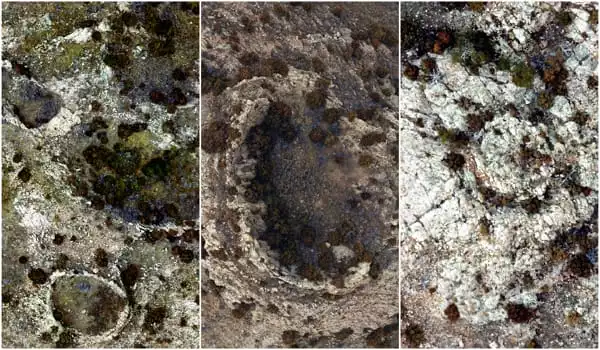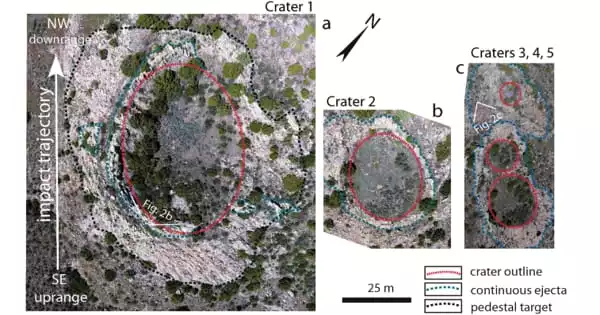Impact cratering is the excavation of a planet’s surface caused by a meteoroid strike. Impacts are instantaneous occurrences. They leave very distinct features. Craters are roughly circular excavated holes caused by impacts. The circular shape is caused by material flying out in all directions as a result of the explosion upon impact, not by the impactor itself having a circular shape (almost no impactors are spherical). Craters are the most common surface features on many solid planets and moons, including Mercury and our own Moon.
Several dozen small impact craters, ranging in size from 10-70 meters, have been discovered in southeastern Wyoming. These ancient craters were discovered by a team of geoscientists from the United States and Germany in exposed Permian sedimentary layers (280 million years ago). When the team first discovered the craters, they assumed they were part of a crater-strewn field formed by the breakup of an asteroid that had entered the atmosphere. However, as more craters were discovered across a larger area, this interpretation was ruled out.
Many of the craters are grouped together and aligned along rays. Furthermore, several craters are elliptical, allowing reconstruction of the impactors’ incoming paths. The reconstructed trajectories are arranged in a radial pattern.
The trajectories show that the craters were formed by ejected blocks from a large primary crater. Secondary craters around larger craters are well known from other planets and moons but have never been discovered on Earth,” the researchers write.
Thomas Kenkmann
“The trajectories show that the craters were formed by ejected blocks from a large primary crater,” said project leader Thomas Kenkmann, a geology professor at the University of Freiburg in Germany. “Secondary craters around larger craters are well known from other planets and moons but have never been discovered on Earth,” the researchers write.
The team used mathematical simulations to model the formation of the craters and calculated the ballistic trajectories. All of the craters discovered so far are 150-200 km from the presumed primary crater and were formed by blocks 4-8 m in size that collided with the Earth at speeds of 700-1000 m/s. The source crater is estimated to be 50-65 km in diameter and should be deeply buried beneath younger sediments in the northern Denver basin near the Wyoming-Nebraska border.

The size and shape of the crater, as well as the amount of material excavated, are determined by factors such as the impacting body’s velocity and mass, as well as the geology of the surface. The larger the crater, the faster the incoming impactor. Materials from space typically hit Earth at a speed of about 20 kilometers (slightly more than 12 miles) per second. A high-speed impact creates a crater that is roughly 20 times the diameter of the impacting object.
Smaller planets have less gravitational “pull” than larger planets, causing impactors to strike at a slower speed. The larger the crater, the greater the mass of the impactor. Circular craters are the most common type of crater. If an impactor strikes the surface at a very low angle — less than 20 degrees — it can produce more elongate craters.
Scientists measure the size and number of impact craters, as well as their erodibility, to determine the ages and histories of various planetary surfaces. There was a lot of large debris striking the surfaces of the young planets and moons early in the formation of our solar system (before 3.9 billion years ago); these older impact basins are larger than the more recent craters. Older surfaces, on average, have been exposed to impacting bodies (meteoroids, asteroids, and comets) for a longer period of time than younger surfaces. As a result, older surfaces have a greater number of impact craters. Mercury and the Moon’s surfaces are riddled with impact craters, indicating that they are very old.
Because of weathering and erosion of the Earth’s surface, impact craters are more difficult to identify. The Moon lacks water, an atmosphere, and tectonic activity, all of which erode the Earth’s surface and erase all but the most recent impacts. Approximately 80% of the Earth’s surface is less than 200 million years old, while the Moon’s surface is more than 3 billion years old. Essentially, the Moon’s surface has not been altered since its early history, so the majority of its craters are still visible.





